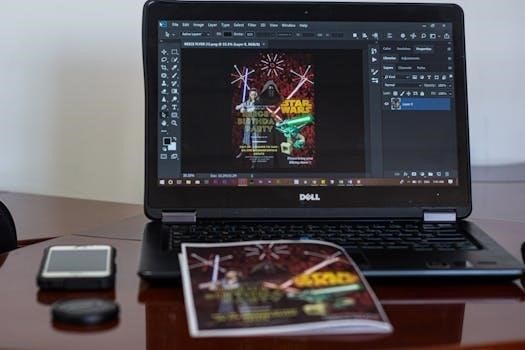Understanding the Need for PDF to MSCZ Conversion
The need to convert PDF to MSCZ stems from the desire to edit and manipulate sheet music digitally. PDFs often represent static images of music‚ while MSCZ is a dynamic format for editing in MuseScore.
Why Convert PDF to MSCZ?
Converting from PDF to MSCZ is essential for musicians and educators seeking to modify or arrange existing sheet music. PDF files‚ while widely accessible‚ are essentially static images‚ limiting their utility for interactive manipulation. The MSCZ format‚ specific to MuseScore‚ allows for dynamic editing‚ playback‚ and transposition of musical scores. This enables users to extract individual parts from a full score‚ customize arrangements‚ and easily share editable music files‚ facilitating collaboration and personalized learning. Ultimately‚ converting a PDF to MSCZ unlocks the full potential of digital sheet music for a variety of musical purposes.

Challenges in Converting PDF to MSCZ
Converting PDF to MSCZ faces hurdles due to the graphical nature of PDFs‚ which are not readily interpreted as musical notation. Optical Music Recognition (OMR) inaccuracies can lead to errors.
The Complexity of Music Notation in PDFs
PDFs‚ while excellent for displaying documents‚ treat music notation as images‚ not as editable data. This presents a significant challenge when converting to MSCZ‚ where notes‚ rhythms‚ and other musical elements must be recognized individually. The intricate symbols‚ varied fonts‚ and layouts of musical scores make it difficult for software to accurately interpret the notation. Furthermore‚ varying PDF quality and the presence of handwritten annotations further complicate the automated recognition process‚ requiring sophisticated Optical Music Recognition (OMR) algorithms to decipher the musical information effectively.
Methods for PDF to MSCZ Conversion
Converting PDF to MSCZ can be achieved through MuseScore’s import feature or online converters. These methods vary in accuracy and may require manual adjustments after conversion.
Using MuseScore’s Import Feature
MuseScore offers a direct import function for PDF files‚ aiming to transform them into editable MSCZ format. This involves opening the software and selecting the import PDF option from the file menu. While convenient‚ the success of this method heavily relies on the quality of the PDF. It may struggle with complex layouts‚ poor scans or handwritten scores‚ often requiring manual correction of the imported notation to ensure accuracy. After import‚ users can save the composition to an MSCZ file‚ enabling editing and adjustments within MuseScore.
Utilizing Online Converters
Online converters offer a convenient way to transform PDF files to MSCZ format‚ often involving a simple upload and download process. Users upload their PDF sheet music‚ the service processes it‚ and provides an MSCZ file for download. These services may vary significantly in accuracy‚ depending on the complexity of the music and the quality of the original PDF. While they can be quick and accessible‚ users must be aware that the converted MSCZ file might require manual editing in MuseScore to fix any errors or misinterpretations. Many such tools are free for use.
Software Solutions for PDF to MSCZ
Dedicated software solutions‚ often employing Optical Music Recognition (OMR)‚ are available for converting PDF to MSCZ. These tools aim for higher accuracy in interpreting musical notation.
Exploring Optical Music Recognition (OMR) Tools
Optical Music Recognition (OMR) tools are specialized software designed to interpret scanned or PDF images of sheet music. These tools analyze the visual elements of musical notation‚ such as notes‚ clefs‚ and rhythms‚ and convert them into a digital‚ editable format. While not always perfect‚ OMR software is crucial for automating the conversion process from PDF to MSCZ‚ reducing the need for manual transcription. They utilize algorithms to identify musical symbols and their relationships‚ aiming to reconstruct the musical score accurately. However‚ the success of OMR heavily depends on the quality of the input PDF.
PlayScore 2 as a Conversion Option
PlayScore 2 emerges as a viable solution for converting PDF files into editable music formats‚ particularly XML‚ which is compatible with MuseScore. This application is designed to scan sheet music‚ whether from photos‚ PDFs‚ or images‚ and transform them into digital scores. It stands out as a potentially cost-effective and accurate method for sheet music scanning. PlayScore 2 offers the ability to play music directly from the scanned input‚ making it useful for both conversion and immediate playback. Its ability to generate XML files allows seamless import into MuseScore for further editing and refinement;

Alternative Formats for Import
When direct PDF to MSCZ conversion proves difficult‚ consider using intermediate formats. Converting to MIDI or XML first can facilitate importing music data into MuseScore effectively.
Converting PDF to MIDI or XML First
Direct conversion from PDF to MSCZ can be challenging‚ prompting the use of intermediary formats like MIDI or XML. These formats‚ especially MusicXML‚ are designed for music data and can be imported into MuseScore more easily. Converting PDF to MIDI or XML first often involves using Optical Music Recognition (OMR) software to extract musical information from the PDF. While not always perfect‚ this approach provides a more structured pathway for getting the music into an editable format‚ which can then be refined within MuseScore to achieve better results than a direct conversion attempt.

Limitations and Workarounds
Poor PDF quality significantly impacts conversion accuracy. Workarounds include manually correcting errors‚ using better OMR tools‚ or converting to intermediary formats like XML or MIDI for improved results.
Dealing with Poor Quality PDFs
Converting poor quality PDFs to MSCZ often presents significant challenges‚ as optical music recognition (OMR) software struggles with blurry‚ skewed‚ or low-resolution images. This results in inaccurate note and rhythm detection‚ requiring manual correction. Users might need to enhance the PDF’s clarity using image editing software before conversion. Another approach involves separating parts into individual files and converting them separately before combining them in MuseScore. Ultimately‚ patience and manual adjustments are often necessary to achieve satisfactory results when starting with a subpar PDF. It is better to have a clear source to start with.
Editing and Adjusting After Conversion
After converting to MSCZ‚ editing and adjustments are usually required. This may include correcting note pitches‚ durations‚ and rhythms‚ as well as adding articulations and dynamics to the score.
Refining the MSCZ File in MuseScore
Once a PDF has been converted to MSCZ‚ the file often needs refining within MuseScore. This process involves correcting any errors in note placement‚ duration‚ and rhythm‚ which may arise from imperfect conversion. Users can adjust dynamics‚ articulations‚ and other musical markings to ensure accuracy and clarity. Additionally‚ the layout of the score may require tweaking‚ such as adjusting spacing between notes‚ staves‚ and systems. Proper formatting is necessary for a professional and easy-to-read score‚ so this step is very crucial after any conversion process.

Exporting MSCZ to PDF
The reverse of the conversion‚ exporting MSCZ to PDF‚ is straightforward in MuseScore; This allows for easy sharing and printing of the edited musical score in a universally accessible format.
The Reverse Process⁚ MSCZ to PDF
Once a musical score has been edited or created within MuseScore as an MSCZ file‚ the process of converting it to a PDF is quite simple. This allows for easy sharing of the score‚ as PDFs are widely accessible and maintain consistent formatting across different devices and platforms. To perform this reverse conversion‚ one would typically open the MSCZ file in MuseScore and select the “Export” option. The user can then choose PDF as the desired output format. This feature ensures the edited or created scores can be easily distributed and printed.
